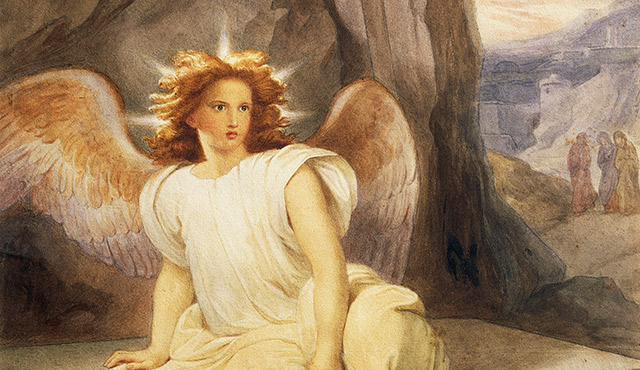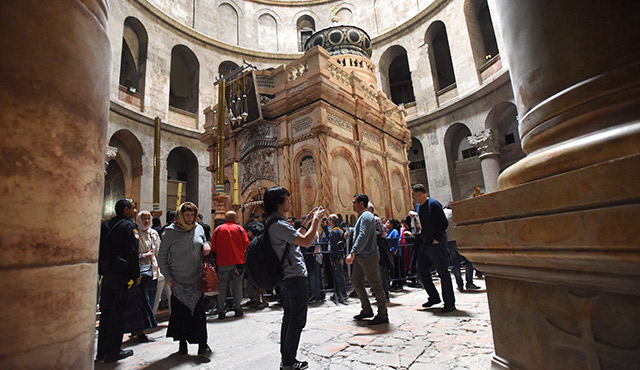Picture the remaining 11 apostles, on a cold spring evening, fugitives huddled together, afraid to stay put, afraid to go out. It seems like an eternity since they shared the Passover meal with Jesus. Now He is dead – delivered to a gruesome crucifixion by their own High Priests at the hands of their Roman conquerors and oppressors. Early the next morning, the women would go out before dawn to the heavily guarded tomb, somehow hoping to gain entry to perform the ritual anointing. All their hopes and dreams of a Messiah seemed buried in that cold dark tomb.
Then the world changed. Standing at the open and empty tomb, the women were the first witnesses to the fulfillment of a promise made at the dawn of mankind by the one almighty God. The truth of this moment is fundamental to Christian faith. As Paul says in 1 Corinthians 15:17 “and if Christ has not been raised, your faith is vain; you are still in your sins.” St. Paul, sensing that the Corinthians, let alone future generations might need more proof, goes on to state that the risen Jesus appeared to 500 brothers, Cephas (St. Peter), St. James and eventually to St. Paul. Other accounts cite many appearances over the next 40 days.
But two thousand years later, how do we know empirically that the cornerstone of our faith is in fact true? Did the apostles hide Jesus’ body, and make up the Resurrection story as a cover to start a new religion? Or maybe it was just a “symbolic” resurrection in spirit, a case of mass hysteria or hallucination?
The first step in evaluating hoax theories is to look at the historical setting and the serious trouble the apostles were in with the Temple and the Romans. There was a reason why Peter denied Jesus three times – he was scared to death to admit he had anything to do with Him. None of the apostles except John were at the foot of the cross for the same reason. They were in hiding from the Roman soldiers and temple guards who, in trying to nip any thoughts of revolt in the bud, might easily round up Jesus’ followers and subject them to a similar fate.
According to Catholic author and radio host Patrick Madrid, “If Jesus’ literal, bodily Resurrection didn’t happen, the Apostles would have disbanded, given up, and gone home. What would have been the point? If Jesus did not really rise from the dead, as he had repeatedly promised he would, then why bother? He would have been just another failed, dead wannabe Messiah. And the Apostles and the other disciples who followed Jesus certainly would not have been willing to risk their lives (as they did) and suffer bloody martyrdom (as they did) for some dead guy who had an inspiring message. But the Resurrection proved that Jesus is God, and that he’s our Lord and Savior, whose person and message is worth living for and, should it come to that, worth dying for. That’s what we believe as Catholics about the Resurrection. It’s that life-changingly, world-shakingly important.”
Another theory is that all the stories about Jesus’ appearances can be explained away as mass hysteria or hallucination. According to Catholic Answers’ Apologist Karlos Broussard, “How can so many different people hallucinate the same thing or have the same vision at different times and in different places and draw from it the same erroneous conclusion? It doesn’t make sense. With respect to hallucinations, clinical psychologist Gary Collins explains: ‘Hallucinations are individual occurrences. By their very nature only one person can see a given hallucination at a time. They certainly are not something which can be seen by a group of people…Since a hallucination exists only in this subjective, personal sense, it is obvious that others cannot witness it.’”
One of the more controversial proofs is the shroud. The Gospel of Luke states, “But Peter got up and ran to the tomb, bent down, and saw the burial cloths alone; then he went home amazed at what had happened.” Lk 24:12. Both Luke and John specifically mention the burial cloths. The fact that the cloths were there does not necessarily prove the Resurrection, but was there something about the cloths that indicated Resurrection? The empty cloth didn’t send the Apostles out looking for a body, it sent them home, amazed and presumably joyful. Ian Wilson, one of the most prolific authors and historians on the subject of the Shroud of Turin postulates, “But why the excitement, even on the part of an Agnostic? Although many may wonder why anyone would find a few stains on an old piece of linen so fascinating, it is the character of those stains which is so compelling. The plain fact is that no normal human body leaves behind an image of itself, certainly not one with the extraordinarily photographic characteristics that is on the Shroud. Can it be by accident therefore that this phenomenon has happened uniquely in the case of Jesus, the one man in all human history accredited with breaking the bonds of death? If the shroud really is two thousand years old, would whatever happened at that moment in time quite literally have flashed itself on the cloth that we have today, a now permanent time capsule of how Jesus’ body looked at the time of resurrection?”
There are many other proofs historic, contextual and cultural that testify to the truth of the Resurrection, but Father Christopher Smith, Rector of Christ Cathedral Parish points out, “The declaration of Easter is that the resurrection of Jesus broke through the finality of physical death and destroyed the power of sin which deadens our spirits. The promise of Easter is new and everlasting life.”


